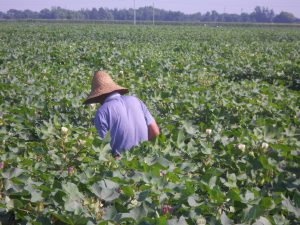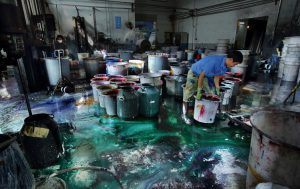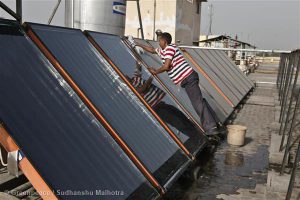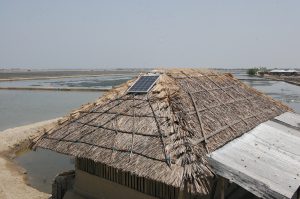"Fast fashion" has been one of the big developments in clothes retailing over the last decade, where pile ’em high, sell ‘em cheap versions of the latest trends are rolled out rapidly and on a huge scale, with the cycle repeated many more times during the year than was typical with seasonal style collections.
As it is a marketing approach based in large part on supplies of cheap cotton, major producing countries such as China are paying a heavy environmental price in terms of soil quality and water supply.
For western clothing brands that use China for most key stages in their supply chains, the falling cotton price and central government’s decision to scrap a price floor may seem like commercial good news. But it risks endangering future cotton supply, according to a new report from CottonConnect, a clothing industry-funded enterprise.
Weak prices mean that farmers may have to switch to other crops or leave the land altogether, the report says.
This would mean lower production of the crop, and higher prices for buyers in the longer term, a trend that may eventually have to be passed on by retailers in a highly price-sensitive sector.
But increasingly for European and North American clothing retailers looking to improve their image, there are strong environmental reasons for keeping cotton farmers on the land and paying for schemes to cut down on the use of water and fertiliser when growing cotton.
The loss of almost 1,200 lives when the Rana Plaza clothing factory building collapsed in Bangladesh in 2013 shone the harshest of lights on the human cost of low-wage, outsourced manufacturing of cheap clothing for western retailers.
But at the start of the production chain, the environmental impact of cotton production is also coming under increasing scrutiny as water supplies in countries such as China become increasingly scarce.
CottonConnect, which is funded by retailers including C&A, the John Lewis Partnership, M&S and Primark, is aiming to improve the image of the clothing retail industry by using sustainable business practices.
In the report, the organisation reckons that ‘sustainable cotton’ could make a big difference to reducing soil erosion and water waste in China, which supplies almost 60% of the world’s cotton.
Although demand for the commodity is still largely driven by sales of low-cost clothing, a growing trend for organically-grown crops in richer countries could help improve the lives of farmers and improve environmental practices, CottonConnect says.
Xinjiang project
The benefits could be most apparent in the arid, dusty north-western province of Xinjiang, China’s poorest and most politically-restive region that farms over half of China’s cotton.
Here, CottonConnect is managing projects to improve productivity and reduce environmental impacts, which now includes 4,000 farmers across 11,000 acres, producing 8,500 tonnes of cotton.
The organisation has also teamed up with the Better Cotton Initiative, a clothing industry initiative, which is implementing sustainable practices across 8,000 acres.
Although these schemes cover just a tiny percentage of Xinjiang’s annual cotton output of around 3 million tonnes, CottonConnect hopes to broaden the techniques to other parts of the western province and in other countries.
Only 6% of the world’s cotton is judged to be sustainable by meeting several different industry standards, says CottonConnect. But at present almost of none of the cotton that is certified as ‘sustainable’ is produced in China.
Undaunted, CottonConnect says it hopes various initiatives worldwide will raise the share of sustainable cotton in global production to 30% by the end of the decade by encouraging less wasteful practices in the world’s major producing countries, which also include India, US, Pakistan and Brazil.
The manufacture of a cotton-shirt can use on average 2,500 litres of water globally, but in China the figure is likely to be more. Cotton production is said to account for around 2.5% of global water use.
Improvements
Up to 60% of the water used in the manufacture of a cotton garment is in the fields, but this can be reduced massively through drip irrigation, says Alison Ward, chief executive of CottonConnect.
Mulching of soil and covering waterways can help reduce the use of fertilizer and pesticides, improve soil quality and cut down on erosion, Ward adds.
“Simple interventions can make a huge difference,” she says.
In other countries where greener methods have been monitored, the benefits are clear. A recent field study in India has showed that better environmental practices reduced use of agrochemicals of 81%, led to a 49% cut in the amount of water, an 18% reduction in chemical fertiliser use, and a 15% increase in the profitability of farms.
In Xinjiang, farmers have two water sources, the Tarim River and groundwater, with snowmelt offering a welcome, but erractic, additional supply.
But CottonConnect says the water table in Xinjiang is lowering fast. Water accessible at 30 metres in previous years is now only found at 80 metres, and flood irrigation is needed at least twice a year to deal with the double challenges of pests and a highly alkaline and saline soil.
Environmental disaster
China’s government is well aware of the environmental problems posed by cotton, and following a huge relocation of the cotton and clothing industry to Xinjiang in the 1990s, the government is trying to encourage cleaner, greener growth in the textile sector, and promote sustainable and productive agriculture and efficient water use.
But for a commodity that is based on high volume and low margins, the environmental benefits of government policy are scarcely evident so far.
Across the border from Xinjiang in central Asian states such as Kazakhstan and Kyrgyzstan, the environmental impact of cotton production is still all too apparent.
Huge Soviet-era irrigation schemes and intensive collective farming of cotton led to the drying up of one of the world’s largest internal seas and turned large swaths of farming land into a giant dustbowl — lessons from history that the world’s cotton producing countries, and the clothing industry, will need to remember.








